To help you understand why we’re not “fake news,” it might help if we explain how newspapers work and the divisions between news reporting and commentary.
What's the difference between ...
A News Story ...
The meat of your newspaper is made of news stories or features: a story about a topic, incident or person of interest. A news story might be about a news conference, a disaster, a trend, a personality profile or an investigation.
-
You may have heard of the five Ws and H: “Who, what, where, when, why and how.” News reporters try to answer these questions in their stories. If they don’t, they’re likely to have their editor send it back to them for additional work.
-
News stories should be timely: They should run in the paper soon after the event happens or the news is announced. You’ll often see a mention of this fairly early in a story: “Thursday, officials revealed ...” We call this a “time peg.”
-
Most reporters are trained to make their first sentence as catchy as possible — frankly, this is aimed at capturing a reader’s attention and encouraging them to read further. We call this “the lede.”
-
After that first sentence, you’ll often see reporters cite important facts next and then maybe go into background material or reaction from other people. Journalists call this “the inverted pyramid.”
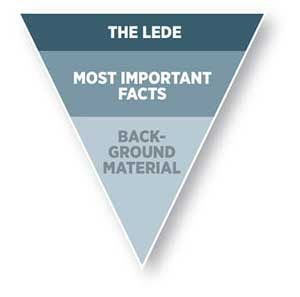
-
Reporters are taught to integrate quotes into their stories. They’ll often call this “attribution.”
-
The more complicated or controversial the topic, the more sources a story should include.
-
A news story should try to cover an issue from several points of view. If the city wants to build a new highway, for example, you might see reaction from frustrated drivers as well as homeowners whose property values might be affected.
-
... from everyone’s point of view except that of the reporter. If the reporter writes her or his own views or begins writing sentences with the work “I” in them, then the news story is more of a column and should be treated that way.
-
And some news stories aren’t really news stories at all — they’re what we call feature stories. They might take a longer view, be arranged in a different way and might push some important information lower in the story. This is done for stylistic purposes. These longer, more entertaining stories are sometimes referred to as “readers,” as in: “My piece for Sunday isn’t really breaking news. It’s a reader.”
-
Typically, a story that starts on a cover has to continue on an inside page. We call this a “jump.”
-
Reporters don’t typically write the headlines on their stories. This is done by the editors who proofread stories for typos and errors: the copy desk, or just “the desk.”
-
Reporters usually work with several layers of supervision. Metro news reporters report to the metro editor, goverment editor or assistant city editor. Sports reporters report to a sports editor and an assistant sports editor. The same applies to business and features staffers. Photographers report to a photo editor, designers to a design editor and the copy editors report to the news editor.
All of them report to a managing editor, Joe Palmquist. And he reports to editor Rob Curley.
An Editorial ...
These run on the Opinions page and often address local, regional and national matters, including candidate endorsements before elections.
The lead editorial reflects the view of Publisher Stacey Cowles. Cowles doesn’t work in the newsroom, and while various news clerks who assist him do, they don't share the editorial page material with Editor Rob Curley and only the copy desk views the page, strictly for proofing before it goes to press.
Here's the Opinions page for Sunday, April 5:
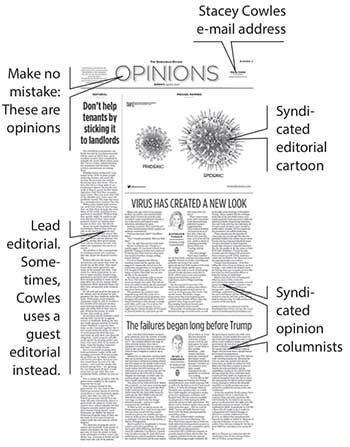
And here's the Op-ed page for Sunday, April 5 (“Op” meaning “opposite to” or across from):
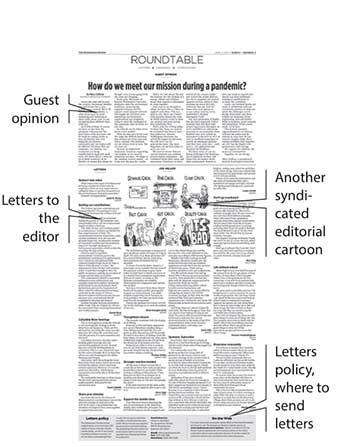
Larger newspapers might have an editorial board that meets every day or several times a week. The general idea for a lead editorial will be hammered out in that meeting and then a staffer assigned to write it.
In very rare instances, an editorial may be deemed so important to the interests of the region that the publisher asks for it to be put on page 1. The last time that happened in The Spokesman-Review: Feb. 27, 2018.
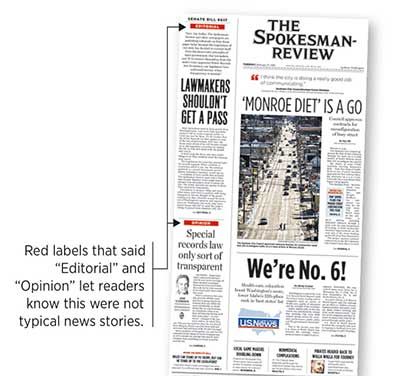
And a Column?
Like most newspapers, The Spokesman-Review has news columnists. These are people who are paid to share their opinions on local and regional news topics. A few examples...

Shawn Vestal
Usually writes about policy, politics and government for our city desk. He’s been with The Spokesman-Review since 1999.
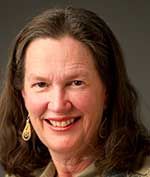
Correspondent Sue Lani Madsen
Rancher and architect, writes from a conservative point of view in Thursday's Northwest section.

Freelancer Audrey Alfaro
Writes the Dorothy Dean recipe column — and takes the photos — for the Wednesday Food section.
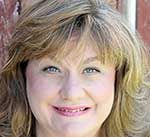
Cindy Hval
Another freelance columnist. Her Front Porch column appears every other Thursday in the Voices section, plus she writes occasionally for the features and other sections of the paper.

John Blanchette
Longtime sports columnist for The Spokesman-Review who now writes on a freelance basis.
-
A column often contains the word “I.” Many columnists write about their personal experiences and will interject themselves into the pieces they write.
And that’s OK. But you should go into a column knowing that.
-
The editors and designers of The Spokesman-Review try to send you a signal that a certain article is a column by using one of two devices — or both:
A “column label” atop the article:

A drawing of the writer in what we call a “column sig”:
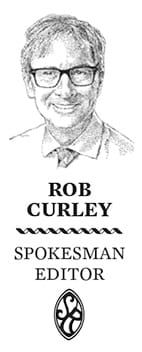
- If you disagree with something a columnist writes, you’re welcome to tell her or him so. Most Spokesman-Review columnists list their email addresses at the bottom of their column.
A Quick Note About Corrections
The entire newsroom here at The Spokesman-Review aims for accuracy.
Most days, we do quite well. But errors happen. When a collection of reporters, photographers, designers and editors handles as much material every day as does the staff of The Spokesman-Review, there will be a number of mistakes that slip into print or online.
But journalists are trained to own up to their errors. If one comes to their attention, they write it up and submit it to publish as soon as possible. These usually run on page 4.
If you spot an error in The Spokesman-Review, call (509) 459-5403 or email news@spokesman.com
Here's an example correction from the paper:
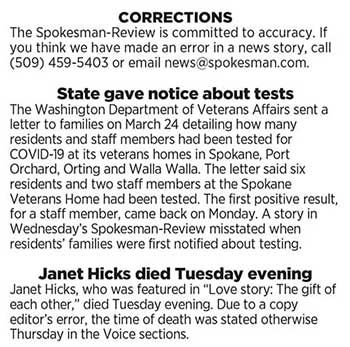
CONTACTS
Rob Curley
Editor
(509) 459-5030
robc@spokesman.com
Liz Kishimoto
Managing Editor (News and Photo)
(509) 459-5402
lizk@spokesman.com
Paul Smith
Managing Editor/Business and Audience
(509) 459-5528
pauls@spokesman.com
Carolyn Lamberson
Asst. Managing Editor (News)
(509) 459-5068
carolynl@spokesman.com
Jonathan Brunt
Asst. Managing Editor (Govt)
(509) 459-5442
jonathanb@spokesman.com
John Stucke
Asst. Managing Editor (Front Page)
(509) 459-5419
johnst@spokesman.com
Lindsey Treffry
Asst. Managing Editor (Copy)
(509) 459-5410
lindseyt@spokesman.com
Ralph Walter
Asst. Managing Editor (Sports)
(509) 459-5471
ralphw@spokesman.com
